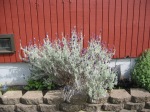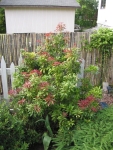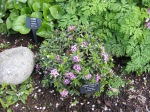Coral Bark Japanese Maple (Acer palmatum “Sango-Kaku”) – 4/28/2010
This is a well known and popular Japanese Maple. It’s called Coral Bark for its bright red stems which are said to resemble a tower of red sea coral. The stems are brightest in Spring when it first starts to grow. This photo shows the tree a couple of weeks after it was planted. It kind of stuns me how small it was 10 years ago! I made a point to get a tree that had a tight vase shape to it. I wanted it to fit here at the intersection of the path from the driveway that goes up into the house on one side, and the path that goes into the front garden on the other.
10/29/2010
Here it is in October with the beginning of fall color on it. This year it had a lot of red in it, but it changes each year and other years it has more gold in it than red, as you’ll see as we go along here. No matter the color, it’s always beautiful.
2/16/2011
You can clearly see the bright red stems in this photo. You can also see how much it’s grown in just one year – it grows fast! It’s a perfect fit for its space and is well away from the paths, as intended.
11/18/2011
It grew even more its first year in the ground. The color this year is stunning, tho most of the leaves have fallen by now.
8/23/2012
I didn’t have a Spring photo for this year so you’re seeing 2 years of growth here. It’s still narrow but getting very full.
10/25/2012
The fall color here is more orange than red, which is more what we’ve seen over time. You can still see the red stems.
5/7/2013
It’s getting really full now and starting to look like a “real tree”, which for me means when it gets taller than my head! I’m only 5’4″ tall so I guess that’s really not a very high bar to meet…
10/31/2013
I guess you can tell this was taken on Hallowe’en. It’s gotten significantly taller this year with vibrant orange color.
5/8/2014
I love how it droops down in this photo. The first full flush of Spring growth covers it here and it’s heavy.
11/1/2014
The new growth at the top always turns color more slowly than the older growth. It’ll get there but it takes awhile.
5/6/2015
It’s still growing in a tight vase shape, with a little help from my lopers. I don’t prune it much, just enough to keep it that way.
10/30/2015
Another Hallowe’en photo. We don’t decorate the house for trick or treaters till Hallowe’en day but you can see the corn stalks we line the driveway with behind the tree on the lawn. The kids love how we do it and we have fun too!
3/25/2016
You can really see the red stems on this one. The leaves are just starting to appear on the branches. It’s still a tight shape.
10/23/2016
This is the typical color it seems to turn most years, tho sometimes it has more red in it, which I personally prefer. Not that I don’t love the colors here. It’s getting much wider at the top but is still narrow where it needs to be out of the way.
2/6/2017
It doesn’t snow every year here in Seattle so I like to take photos when it does. The snow really makes the red stems shine.
10/23/2017
There’s a tinge of red on the upper leaves this year, extending down somewhat to the lower parts. This color makes me happy. The tree is getting both taller and wider here but still stays out of the paths. Only takes bit of pruning to do this.
4/22/2018
It’s so lovely when the leaves first start to grow. I said it looked like a “real tree” earlier. It’s so much more so now!
10/17/2018
Here the fall color is trending more towards a deep yellow rather than much red. Again you can see the top colors up later.
2/9/2019
I took this after a huge snowfall last February that destroyed the big coniferous shrub behind the maple. People called it the “Snowpocalypse”. We almost never get this much snow. I love to look at it but we had a lot of breakage of limbs. Very sad.
10/24/2019
I seem to have a lot of photos taken in October here. You can see how the stems darken to a light brown as they age. If you look closely you can still see some vestiges of red here and there. In the back is a gorgeous Waterfall dissected maple.
6/6/2020
We’re finally up to this year. This was just a few ago, in June, and it’s got quite a lot of new growth on it. But as you’ll see in the next photo it still has a ways to go. I don’t know if you’ve been watching the pine to the right here. It’s gotten a whole lot bigger too. I guess everything has…
9/9/2020
I took this one a couple of hours ago, just before I started this post. Like I said you can see that it’s grown since the last photo I took in June. It Really looks like a “real tree” now. It’s not only taller than I am – it’s way taller than the roof! I had to prune off one branch that was drooping down over the roof when it rained. I try to keep things off the roof, but really we only have 2 or 3 trees that I have to worry about that with. Most of the large trees are far away from the house and garage.
I’ve been so pleased with how fast and strong this tree has grown. It’s wonderful to be able to walk under it when you go into the house. And tho you can’t really see it much here I also trained the maple to merge with the Green Pine on the right to form an arch over the path as you drop down onto the lawn and into the garden. I love tree arches and have created a few more here and there throughout the garden. I’ve even made them with large shrubs. They make it feel like you’re entering a different world and help to create a feeling of enclosure as you walk under them. Maybe I’ll do a post on them sometime.
I hope I’ve given you a good look at how this special tree has grown over time. I tried to get photos that showed it at different times of the year, including early Spring when the tree is bare and in fall when it’s in full color. There are also a few that show it in summer when it’s green and growing. I think it’s awesome all year long.
This tree was introduced in Ireland in 1920 and is now widely planted over much of the world. Eventually it will grow to 30′ or 40′ tall and 20′-30′ wide. I’m glad we have it here in our garden and that it’s taken its place in such a short time.
I hope you have some trees in your garden that you love as much as I love this one!!
Steve







































































